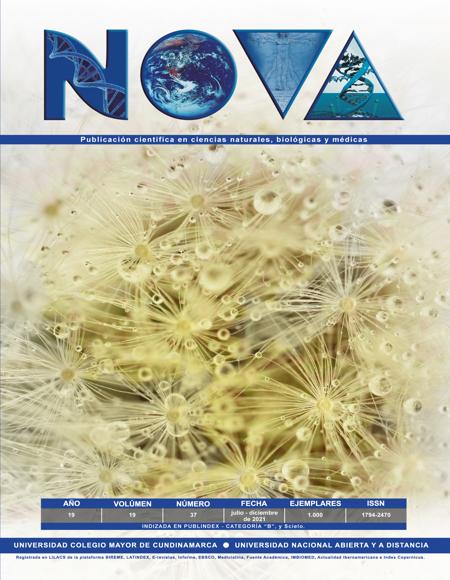PREVALENCIA DE RESISTENCIAS DE BACTERIAS AISLADAS EN HEMOCULTIVOS, EN UN HOSPITAL UNIVERSITARIO DE COLOMBIA
PREVALENCIA DE RESISTENCIAS DE BACTERIAS AISLADAS EN HEMOCULTIVOS, EN UN HOSPITAL UNIVERSITARIO DE COLOMBIA RESISTENCIAS DE BACTERIAS AISLADAS EN HEMOCULTIVOS
Mostrar biografía de los autores
Objetivo: describir la frecuencia de los microorganismos y la resistencia antibiótica de bacterias aisladas en hemocultivos de pacientes con bacteriemia, en un hospital universitario de Colombia. Métodos: Se desarrolló un estudio observacional, descriptivo y de corte transversal, en individuos mayores de 18 años, en donde se describió los hemocultivos positivos, aislados en todos los servicios del Hospital Universitario del Caribe. Resultados: De los 211 hemocultivos analizados, el 53,1% fueron hombres. Los microorganismos Gram positivos corresponden a 49,8%, con una alta frecuencia de S. aureus en un 16,1%. De los microorganismos Gram negativos fue aislado E.coli en un 18%. La resistencia a vancomicina se estableció en 4,4% . La K. pneumoniae presentó una resistencia a meropenem en un 15,3% de los casos. E.coli, P. aeruginosa y E.cloacae son sensibles a carbapénicos. Así en nuestro estudio las bacterias más frecuentemente aisladas en los hemocultivos fueron predominantemente Gram negativos, con resistencia a carbapénicos para algunas cepas de K. Pneumoniae.
Visitas del artículo 425 | Visitas PDF 282
Descargas
1. Lacoste J, Jarlier V, Coignard B, Vaux S. Estimating the morbidity and mortality associated with infections due to multidrug-resistant bacteria ( MDRB ),. Antimicrob Resist Infect Control [Internet]. 2016;5. Available from: http://dx.doi.org/10.1186/s13756-016-0154-z
2. Woolhouse M, Waugh C, Perry MR, Nair H. Global disease burden due to antibiotic resistance – state of the evidence. J Glob Health. 2016;6:010306.
3. Kajumbula H, Fujita AW, Mbabazi O, Najjuka C, Izale C, Akampurira A, et al. Antimicrobial Drug Resistance in Blood Culture Isolates at a Tertiary Hospital, Uganda. Emerg Infect Dis. 2018;24:174–5.
4. Alanis AJ. Resistance to Antibiotics : Are We in the Post-Antibiotic Era ? Arch Med Res. 2005;36:697–705.
5. Fair RJ, Tor Y. Antibiotics and Bacterial Resistance in the 21st Century. Perspect Medicin Chem. 2014;6:25–64.
6. Worthington RJ, Melander C. Combination Approaches to Combat Multi-Drug Resistant Bacteria. Trends Biotechnol. 2014;31:177–84.
7. WHO. Plan de acción mundial sobre la resistencia a los antimicrobianos. Geneva, Switzerland: WHO Document Production Services; 2016. p. 1–30.
8. Powers JH, Evans SR, Aaron S. Studying new antibiotics for multidrug resistant infections : are today ’ s patients paying for unproved future benefits ? BMJ. 2018;360:1–6.
9. Kraker MEA De, Stewardson AJ, Harbarth S. Will 10 Million People Die a Year due to Antimicrobial Resistance by 2050 ? PLoS Med. 2016;13:e1002184.
10. Cassini A, Högberg LD, Plachouras D, Quattrocchi A, Hoxha A, Simonsen GS. Attributable deaths and disability-adjusted life-years caused by infections with antibiotic-resistant bacteria in the EU and the European Economic Area in 2015 : a population-level modelling analysis. Lancet Infect Dis. 2019;19:56–66.
11. WHO. Worldwide country situation analysis : Worldwide country situation analysis : [Internet]. Geneva, Switzerland: WHO Press; 2015. p. 1–43. Available from: www.who.int/drugresistance/en/
12. WHO. Antimicrobial Resistance [Internet]. Copenhagen: World Health Organization Regional Office for Europe; 2017. p. 1–7. Available from: www.euro.who.int/sdgs ©
13. Rasheed MU, Thajuddin N, Ahamed P, Teklemariam Z, Jamil K. ANTIMICROBIAL DRUG RESISTANCE IN STRAINS OF Escherichia coli ISOLATED FROM FOOD SOURCES. Rev Inst Med Trop Sao Paulo. 2014;56:341–6.
14. Farrell DJ, Castanheira M, Mendes RE, Sader HS, Jones RN. In Vitro Activity of Ceftaroline Against Multidrug-Resistant Staphylococcus aureus and Streptococcus pneumoniae : A Review of Published Studies and the AWARE Surveillance Program ( 2008 – 2010 ). 2012;55:206–14.
15. Reiss-mandel A, Regev-yochay G. Staphylococcus aureus and Streptococcus pneumoniae interaction and response to pneumococcal vaccination : Myth or reality ? 2016;351–7.
16. González C, Mendoza-medellín A. Resistencia a cefalosporinas de tercera y cuarta generación en enterobacterias productoras de infecciones nosocomiales y caracterización preliminar de los plásmidos involucrados. Cienc ergo sum. 2008;15:83–90.
17. Karczmarczyk M, Martins M, Quinn T, Leonard N. Mechanisms of Fluoroquinolone Resistance in Escherichia coli Isolates from Food-Producing Animals ᰔ. Appl Environ Microbiol. 2011;77:7113–20.
18. Rath S, Sc M, Padhy RN, Ph D. Prevalence of fluoroquinolone resistance in Escherichia coli in an Indian teaching hospital and adjoining communities. J Taibah Univ Med Sci [Internet]. 2015;10:504–8. Available from: http://dx.doi.org/10.1016/j.jtumed.2015.02.009
19. Abdulgader SM, Shittu AO, Nicol MP, Kaba M. Molecular epidemiology of Methicillin-resistant Staphylococcus aureus in Africa : a systematic review. Front Microbiol. 2015;6:348.
20. Lee AS, Lencastre H De, Garau J, Kluytmans J, Malhotra-kumar S, Peschel A, et al. Methicillin-resistant Staphylococcus aureus. Nat Publ Gr [Internet]. 2018;4:1–23. Available from: http://dx.doi.org/10.1038/nrdp.2018.33
21. Lee S, Han SW, Kim KW, Song DY, Kwon KT. Third-generation cephalosporin resistance of community-onset Escherichia coli and Klebsiella pneumoniae bacteremia in a secondary hospital. Korean J Int Med. 2014;29:49–56.
22. Elshout G, Monteny M, Wouden JC Van Der, Koes BW, Berger MY. Duration of fever and serious bacterial infections in children: a systematic review. BMC Fam Pract [Internet]. 2011;12:33. Available from: http://www.biomedcentral.com/1471-2296/12/33
23. Pien BC, Sundaram P, Raoof N, Costa SF, Mirrett S. The Clinical and Prognostic Importance of Positive Blood. AJM [Internet]. 2010;123:819–28. Available from: http://dx.doi.org/10.1016/j.amjmed.2010.03.021
24. Snyder JW. Blood Cultures: the Importance of Meeting Pre-Analytical Requirements in Reducing Contamination, Optimizing Sensitivity of Detection, and Clinical Relevance. Clin Microbiol Newsl [Internet]. 2015;37:53–7. Available from: http://dx.doi.org/10.1016/j.clinmicnews.2015.03.001
25. Maldonado NA, Múnera MI, López JA, Sierra P, Robledo C, Robledo J, et al. Tendencias de la resistencia a antibióticos en Medellín y en los municipios del área metropolitana entre 2007 y 2012 : resultados de seis años de vigilancia. Biomédica. 2014;34:433–46.
26. Paz-Montes, América Fuenmayor-Boscán A, Sandrea-Toledo L, Piña-Reyes E, López-Dávila M, Navarro-López P. Incidencia de microorganismos en hemocultivos procesados en un hospital del estado Zulia y su resistencia a los agentes antimicrobianos Incidence of Microorganisms in Blood Cultures Processed at a Hospital in the State of Zulia and Resistance. Kasmera. 2015;43:16–33.
27. Navon-venezia S, Kondratyeva K, Carattoli A. Klebsiella pneumoniae : a major worldwide source and shuttle for antibiotic resistance. FEMS Microbiol Rev. 2017;41:252–75.
28. Martin RM, Bachman MA. Colonization , Infection , and the Accessory Genome of Klebsiella pneumoniae. Front Cell Infect Microbiol. 2018;8:4.
29. Fariña N, Carpinelli L, Samudio M, Guillén R, Laspina F, Sanabria R, et al. Staphylococcus coagulasa-negativa clínicamente significativos. Especies más frecuentes y factores de virulencia. Rev Chil infectología. 2013;30:480–8.
30. Xu J, Yan C, Wang L, Zhou Q. Changes of Antimicrobial Resistance among Coagulase-Negative Staphylococci Isolated in 8 Consecutive Years in the First Bethune Hospital. Phys Procedia [Internet]. 2012;33:1190–3. Available from: http://dx.doi.org/10.1016/j.phpro.2012.05.195
31. Duarte-Raya F, Granados-Ramírez MP. Resistencia antimicrobiana de bacterias en un hospital de tercer nivel. Rev Med Inst Mex Seguro Soc. 2012;50:289–300.
32. Lazo-Arispe GF, Mamani -Flores E, Vargas-Loroño E, Camacho-Aguilar JR, Sahonero-Ampuero O. Sensibilidad y resistencia en el antibiograma del Staphylococcus aureus en pacientes del Hospital Clinico Viedma. Rev Científica Cienc Médica. 2013;16:15–7.
33. El-zawahry Y, Abdel-shafi S, Zaki M, El-serwy H. Phenotypic and Genotypic Investigation of Methicillin Resistant Staphylococci Species Isolated from Children with Sepsis in Egypt. Egypt J Bot. 2018;58:11–22.
34. Jeong J, Chang CL, Park TS, Lee SH, Kim SR, Jeong SH. Early Screening of Oxacillin-Resistant Staphylococcus aureus and Staphylococcus epidermidis from Blood Culture. J Korean Med Sci. 2002;17:168–72.
35. Bennett K, Sharp SE. Rapid Differentiation of Methicillin-Resistant Staphylococcus aureus and Methicillin-Susceptible Staphylococcus aureus from Blood Cultures by Use of a Direct Cefoxitin Disk Diffusion Test ᰔ. J Clin Microbiol. 2008;46:3836–8.
36. Walter J, Noll I, Feig M, Weiss B, Claus H, Werner G, et al. Decline in the proportion of methicillin resistance among Staphylococcus aureus isolates from non-invasive samples and in outpatient settings , and changes in the co- resistance profiles : an analysis of data collected within the Antimicrobial Resistance. BMC Infect Dis. 2017;17:169.
37. Adame-g R, Toribio-jimenez J, Vences-velazquez A, Rodr E, Cristina M, Dionisio S, et al. Methicillin-Resistant Staphylococcus aureus (MRSA) in Artisanal Cheeses in México. Int J Microbiol. 2018;2018:6.
38. Famiglietti A, Quinteros M, Vázquez M, Marín M, Nicola F, Radice M, et al. Consenso sobre las pruebas de sensibilidad a los antimicrobianos en Enterobacteriaceae. Rev Argent Microbiol. 2005;37:57–66.
39. Turnidge J. Cefazolin and Enterobacteriaceae : Rationale for Revised Susceptibility Testing Breakpoints. Med Microbiol. 2011;52:917–24.
40. Gutiérrez Lesmes O. Revista CUIDARTE. Rev Cuid. 2015;6:947–54.
41. Sader HS, Jones RN, Andrade-baiocchi S, Biedenbach DJ, Sentry T, Group P, et al. Four-year evaluation of frequency of occurrence and antimicrobial susceptibility patterns of bacteria from bloodstream infections in Latin American medical centers. Diagn Microbiol Infect Dis. 2003;44:273–80.
42. Velásquez J, Hernández R, Pamo O, Candiotti M, Pinedo Y, Sacsaquispe R, et al. Klebsiella pneumoniae resistente a los carbapenemes . Primer caso de carbapenemasa tipo KPC en Perú. Rev Soc Peru Med Interna. 2013;26:192–6.
43. Echeverri-toro LM, Rueda Z V, Maya W, Agudelo Y, Ospina S. Klebsiella pneumoniae. Rev Chil infectología. 2010;29:175–82.





